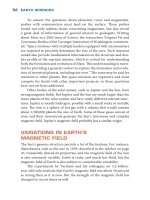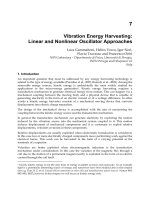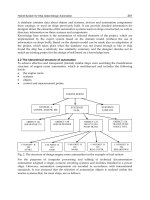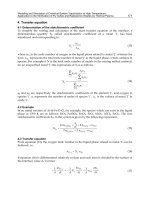EARTH SCIENCES - Notable Research and Discoveries Part 10 ppsx
Bạn đang xem bản rút gọn của tài liệu. Xem và tải ngay bản đầy đủ của tài liệu tại đây (275.89 KB, 17 trang )
196
aquifer underground area that has enough water to supply a well
asthenosphere a weak layer of rock in the upper mantle
caldera a basin or sink formed by the collapse of a volcano
chron See magnetic chron
compression waves propagating disturbances in which material
alternately squeezes (compresses) and pulls apart
convection mechanism of heat transfer by which ows of material
such as liquid or molten rock carry heat from warm to cool regions
crust thin layer covering Earth’s surface, extending from continents to
an average depth of about 22 miles (35 km) and from the ocean oor to an
average depth of about four miles (6.4 km)
current in electricity, a ow of electric charges
desalination removal of salt and minerals from seawater in order to
render it drinkable
dormant describes a volcano that has been inactive for a considerable
period of time
electrons negatively charged particles normally found in motion
around an atom’s nucleus
epicenter in seismology, the ground directly above an earthquake’s
focus
GLOSSARY
FOS_Earth Science_DC.indd 196 2/8/10 10:59:55 AM
196
197
fault break or crack in rocks where one side has moved relative to
another
focus in seismology, the site of an earthquake’s origin, or initial
disturbance, which is usually located under the surface and propagates
from this point in all directions
fossil fuels energy resources—oil, coal, and natural gas—formed
long ago from the remains of organisms
hydrology the study of the properties, distribution, and circulation
of water
inner core Earth’s solid center, composed of iron with a little nick-
el, with a radius of about 756 miles (1,220 km)
ions charged particles
isotopes atoms of the same element but with di erent numbers of
neutrons
lava molten rock that erupts from a volcano
lithosphere crust and uppermost mantle to a depth of about 60
miles (100 km)
M
w
moment magnitude scale (sometimes abbreviated as M)
magma molten rock beneath Earth’s surface
magnet an object having the capacity to exert an attractive force on
iron in its vicinity
magnetic chron period in which Earth’s magnetic eld is rela-
tively stable at one orientation or the other
magnetic field a region of space in which a magnet exerts its
forces
magnetic pole one of the ends of a magnet
magnetometers instruments designed to measure magnetic
elds
Glossary
FOS_Earth Science_DC.indd 197 2/8/10 10:59:55 AM
earth ScienceS
198
magnetosphere the magnetic eld surrounding a planet or star
and extending into space
mantle the rocky region of Earth’s interior extending from the crust
to about 1,800 miles (2,900 km) below the surface
Moho See Mohorovicic discontinuity
Mohorovicic discontinuity boundary between the crust and
mantle
moment magnitude a measure of the energy of an earthquake,
based on the movement of the rocks at the origin
outer core hot, liquid region of Earth’s interior, composed mostly
of iron and nickel, extending from the mantle to a depth of about 3,200
miles (5,150 km)
P waves See primary waves
paleomagnetism record of Earth’s magnetic eld as stored in the
structure of old rocks
plumes channels of exceptionally hot material within Earth’s crust
and mantle
potable suitable for drinking
precipitation in weather systems, a fall of water of some form—
rain, snow, or ice
primary waves fast seismic waves that are rst to arrive at a given
point from an earthquake; these waves are a type of compression wave
radioactivity emission of energetic particles from the nucleus of
unstable atoms
relative humidity amount of water vapor in the air, given as a
percentage of the maximum amount of water vapor that air can hold at
the same temperature
Richter scale a
system of judging the magnitude of an earthquake
from
the size of its seismic waves; developed in 1935 by Charles F. Rich-
ter (1900–85) and Beno Gutenberg (1889–1960)
FOS_Earth Science_DC.indd 198 2/8/10 10:59:55 AM
199
S waves See secondary waves
saturated zone subsurface area in which all the pores in the rock
and soil are lled with water
secondary waves the second waves to arrive at a given point
from an earthquake; these waves are a type of shear wave and do not
propagate through uid
sedimentary rock formed when material such as sand, mud,
and calcium carbonate shells is buried and compressed
seismic waves vibrations in the ground produced by earthquakes
shear waves disturbances in which the displacement is perpen-
dicular to the direction of propagation
SQUID See superconducting quantum interference device
strain deformation caused by applied forces
superconducting quantum interference device an in-
strument that is highly sensitive to magnetic elds and can detect and
measure exceptionally weak elds
tectonic plates large slabs of lithosphere that glide slowly along
Earth’s surface
United States Geological Survey government agency es-
tablished in 1879 to conduct mapping and geological studies
vadose zone the portion of the underground that is dry or par-
tially dry and exists between the surface and the saturated zone
water table the boundary between the saturated zone and the
vadose zone; in other words, it is approximately the “surface” of the
underground water
Glossary
FOS_Earth Science_DC.indd 199 2/8/10 10:59:55 AM
200
Print and Internet
Allaby, Michael, Robert Coenraads, et al. e Encyclopedia of Earth:
A Complete Visual Guide. Berkeley: University of California Press,
2008. is reference work o ers spectacular pictures of Earth’s var-
ied geology and landscapes, along with simple explanations of many
natural phenomena. Main sections of the book discuss Earth’s his-
tory, the dynamics of the interior, rocks and minerals, weather and
climate, water, and the ways the planet and its geology have a ected
human society.
Forget, François, François Costard, and Philippe Lognonné. Planet Mars:
Story of Another World. Berlin: Praxis Publishing, 2008. is book is a
translation of a 2006 volume that discusses what scientists have learned
about the evolution and geology of Mars. Although colder and more
distant from the Sun than Earth, Mars has a fascinating structure, in
some cases exhibiting features similar to terrestrial geology.
Fortey, Richard. Earth: An Intimate History. New York: Vintage, 2005.
Fortey, a scientist at the Natural History Museum in London, surveys
the planet and shows how geological processes have shaped the land-
scape. Readers get a guided tour of Vesuvius, the Hawaiian Islands,
the Grand Canyon in Arizona, and many other fascinating sites that
display and exemplify a great deal of Earth’s evolution.
Johnston, Andrew K. Earth from Space. Bu alo, N.Y.: Fire y Books, 2004.
Satellites have played a crucial role in geology, letting researchers study
broad swaths of the planet with the ick of a switch. Johnston, a geog-
rapher in the research department of the National Air and Space Mu-
FURTHER RESOURCES
FOS_Earth Science_DC.indd 200 2/8/10 10:59:56 AM
200
201
seum, selected 300 satellite images that provide a beautiful, global
view of the planet.
Lewis, Cherry. e Dating Game: One Man’s Search for the Age of the
Earth. Cambridge: Cambridge University Press, 2002. Arthur Holmes
is not well known in the annals of the history of science, but his con-
tributions to the determination of Earth’s true age make a fascinating
story. In the early 20th century, when many scientists believed Earth
was only a few million years old, Holmes’s study of radioactivity de-
rived a much more accurate age of several billion years.
Lomborg, Bjørn. e Skeptical Environmentalist: Measuring the Real
State of the World. Cambridge: Cambridge University Press, 2001.
Lomborg, a professor at the University of Aarhus in Denmark when
he wrote this book, gained much notoriety when he criticized the
global warming researchers who believe Earth’s climate will con-
tinue to change rapidly and perilously. Lomborg’s opinion is that
the dire warnings of these researchers are exaggerated. People who
summarily dismiss skeptics such as Lomborg would do well to keep
this in mind: Contrarian views, while o en wrong, can contain im-
portant truths that are missed by researchers who jump on whatever
bandwagon happens to be popular at the moment.
McPhee, John. Annals of the Former World. New York: Farrar, Straus
and Giroux, 1998. McPhee is a journalist and gi ed writer who
accompanied a group of geologists on a series of tours across the
United States. is book describes the many geological features he
saw and how geologists explain them. Even ordinary-looking rocks,
exposed when highway workers cut a path for the road, have an in-
teresting story to tell about Earth’s past and present.
National Aeronautics and Space Administration. “Welcome to the
Planets.” Available online. URL:
Accessed May 4, 2009. NASA geologists have the whole solar sys-
tem to study, including Earth. is Web resource includes images
and pro les of the planets and other bodies (including Pluto) and
information on space missions such as Mars Global Surveyor and
Voyager.
Repcheck, Jack. e Man Who Found Time: James Hutton and
the Discovery of Earth’s Antiquity. Cambridge, Mass.: Perseus
Further Resources
FOS_Earth Science_DC.indd 201 2/8/10 10:59:56 AM
earth ScienceS
202
Publishing, 2003. Hutton, an 18th-century Scottish farmer and
naturalist, is one of the founders of modern geology. Most peo-
ple in the 18th century were convinced that Earth was young, but
Hutton’s observations of rock formations and other geological
features, and the theories with which he explained them, sug
-
gested that the planet was vastly older. Hutton’s ideas, as those of
Galileo before him and Darwin aerward, were crucial strides in
the progress of science.
Silver, Jerry. Global Warming and Climate Change Demystied. New
York: McGraw-Hill, 2008. e “Demystied” line of books aims to
explain a complex topic as simply and accurately as possible. is
book, written by a science teacher, discusses the data, research tech
-
niques, and hypotheses of global climate change.
Space.com. “All About the Planets.” Available online. URL: http://
www.space.com/planets/. Accessed May 4, 2009. Links to images,
articles, news, and research on the planets are collected on this
page. Comparisons of Earth with the other bodies of the solar sys
-
tem (and beyond) helps geologists to understand planetary struc-
ture and evolution.
University of California Museum of Paleontology. “Tour of Geologic
Time.” Available online. URL: />exhibits/geologictime.php. Accessed May 4, 2009. e tour starts
from Earth’s beginning, about 4.5 billion years ago, and provides
information
on the geology and life-forms that existed at any given
time in the planet’s history.
U.S. Environmental Protection Agency. “Climate Change.” Available
online. URL: Accessed May 4,
2009. e EPA’s Web site on global warming and climate change
provides information on basic issues, the science of climate change,
greenhouse gas emissions, health and environmental eects, climate
economics, and climate policies and regulatory initiatives of the U.S.
government.
U.S. Geological Survey. “Geology Research and Information.” Available
online. URL: Accessed May 4, 2009. USGS,
the government agency involved in mapping and geological studies,
maintains this collection of data and news of the latest research.
FOS_Earth Science_DC.indd 202 2/8/10 10:59:57 AM
203
———. “e USGS and Science Education.” Available online. URL:
Accessed May 4, 2009. Links to a wide
variety of educational resources can be found here. Categories in
-
clude primary grade (K–6) resources, secondary grade (7–12) re-
sources, publications, maps, images, videos, and more.
Weisman, Alan. e World Without Us. New York: omas Dunne
Books, 2007. Human civilization has le its mark on the planet,
but it is not an indelible one, and it is fascinating to consider what
would happen if the world was le to its own devices once again. (In
other words, what would happen if humans become extinct.) is
book describes the subsequent decay of buildings, roads, and other
structures and how this decay would aect the planet and the future
course of life.
Web Sites
Exploratorium. Available online. URL:
Accessed May 4, 2009. e Exploratorium, a museum of science, art
and human perception in San Francisco, has a fantastic Web site full
of virtual exhibits, articles, and animations, including much of inter
-
est to geologists and geologists-to-be.
Geology.com. Available online. URL: . Accessed
May 4, 2009. is site covers the whole spectrum of geology, from
practical engineering issues such as oil drilling, to theoretical con-
cerns such as the cause
of tsunamis. Sections include news, ca-
reers, articles, maps, satellite images, and a dictionary of geological
terms.
How Stu Works. Available online. URL: stuworks.
com/. Accessed May 4, 2009. is Web site hosts a huge num-
ber of articles on all aspects of technology and science, including
geology.
ScienceDaily. Available online. URL:
Accessed May 4, 2009. An excellent source for the latest research
news, ScienceDaily posts hundreds of articles on all aspects of sci-
ence. e articles are usually taken from press releases issued by the
researcher’s institution or by the journal that published the research.
Further Resources
FOS_Earth Science_DC.indd 203 2/8/10 10:59:57 AM
earth ScienceS
204
205
Main categories include Fossils & Ruins, Mind & Brain, Earth & Cli-
mate, Matter & Energy, and others.
U.S. Geological Survey. Available online. URL:
Accessed May 4, 2009. e Web pages of USGS contain an enormous
quantity of excellent information and resources, including maps,
imagery, seismology, earth science, geography, and much else.
FOS_Earth Science_DC.indd 204 2/8/10 10:59:57 AM
205
INDEX
Note: Page numbers in italic
refer to illustrations; m
indicates a map; t indicates
a table.
a
acoustics 6–8
a ershocks 175
Agricultural Research Service
(USDA) 143–144, 148
agriculture 129, 131,
140–141, 143–144
Agriculture, U.S. Department
of (USDA) 143, 146
air conditioners 112–114
Alaska 3, 45, 102, 163
alternating current (AC) 103
Amelung, Falk 90–91
amplitude 164–165
Amundsen, Roald 40, 61
Andrews, Barry S. 108
animal behavior 39, 173–
174, 186
Antarctica 42, 42, 149
Aqua satellites 145,
145–146, 154
aqueducts 128–129, 153
aquifers 136–138, 148, 153
Arctic sea ice 149
asteroids 58–59
asthenosphere 22–23, 165
atmosphere 192–193
aurora australis/borealis
44–45, 45
Australia 119–121, 120, 124
Australian Antarctic Division
42
b
Bada, Je rey L. 193–194
Belonoshko, Anatoly B.
26–27
Beroza, Gregory C. 176,
180
Bertka, Constance 52
binary power stations 106
bird migration 39
Bloxham, Jeremy 49, 62
Bosilovich, Michael G. 151
British Geological Survey
(BGS) 53
Brunhes, Bernard 57, 61
Brush, Stephen G. 1–2
Bush, George W. 49
butter y e ect 144–145,
149, 153
C
caldera 71
California
earthquakes 158–159,
159, 160, 177–178,
179–180, 181, 182
geothermal energy 102,
106, 109, 111, 121, 123,
124
San Andreas Fault 167,
168, 169m, 170, 170,
181, 184, 186
San Andreas Fault
Observatory at Depth
(SAFOD) 181–183
California Geological Survey
160, 177, 181
California Institute of
Technology 9, 164, 174
Canada, Geological Survey
of 40–41
Carlsbad Caverns (New
Mexico) 17, 20, 113
Carnegie Institution of
Washington 25, 52
Carrizo Plain 170
Cavendish, Henry 1
caves 17, 20, 113
Cecchi, Filippo 29, 186
Chang, Wu-Lung 91
chaos 144–145
Chikyu 16–17
China 34, 158, 163–164, 171,
174, 179, 187
chrons 56, 57
cinder cone volcanoes 70,
71
Clark, Jack 40–41
FOS_Earth Science_DC.indd 205 2/8/10 10:59:58 AM
earth ScienceS
206
Clement, Bradford M. 58, 59
climate change 41, 72–73,
108, 148–151
Clouard, Valérie 87–88
clouds 133
cloud seeding 134–135
Columbus, Christopher xvii
comets 58–59
Commerce, U.S.
Department of 146–147
compasses 34, 39, 53, 61
compression waves.
See
longitudinal waves
(compression waves,
primary [P] waves)
computer models and
simulations 26–27,
49–50, 58–59, 87–88, 150,
183–184
condensation 133
conduction 21, 101
Conti, Piero Ginori 102,
124
continental dri 5, 21, 30,
55, 92–93, 165
convection 21, 101
convection currents 23,
48, 100
convection plume
hypothesis 82–86
Cooper Basin EGS project
118–121,
120, 122–123,
124
core 35, 47
covalent bonds 130
Cretaceous period 84
Crowhurst, Jonathan C.
25–26
crust (Earth layer) 4, 4–5,
21, 113
crust-mantle boundary
(Mohorovicic
discontinuity, Moho) 13,
15–16, 30
Curie temperature 37
CUSS I 19
d
Darwin, Charles 192
Davaille, Anne 83–85
deformation 182–184
demagnetization 37
density (Earth’s interior)
1–2
desalination 142–143, 154
deserts 142
diamond anvil cells
25–26
Dietz, Robert 21, 55, 62
dipoles 36
divergence 55
DOE. See Energy, U.S.
Department of (DOE)
domains 37
dome volcanoes 70, 70
drilling 15–17, 18–19,
30–31, 109–112
droughts 129, 139,
140–141, 146–147, 149,
150–151, 153
dry steam power plants
104, 105–106
dust bowl (1930s)
140–141, 150, 153
dynamo theory 47–51
E
Earth facts. See also E arth’s
interior, exploration of
density 1–2
diameter of xv–xvii
at Earth hypothesis
xv
layers 10–15
radius 2
similarities to Mars 28
view from space xvi
Earth Observing System
(N
ASA) 145–146
Earthquake Arrival
Recording Seismic System
(EARSS) 8
earthquakes 158–191
animal behavior and
173–174
damage and casualties
from 158–160
duration 162
epicenter 161–162
fault zones 165–171
focus (hypocenter) 9,
159, 161, 162
forecasts and
probabilities
177–178
and geothermal energy
122–123
global satellite
monitoring system
184–186
how and why they
occur 164–171
measuring intensity of
9–10, 162–165, 186,
187
predictions and
consequences
178–180
San Andreas Fault
Observatory at Depth
(SAFOD) 181–183
seismic (earthquake)
waves 8, 9, 159–162,
162, 175
signs of 175–177
strain accumulation and
surface deformation
181–184
tectonic plates and
160. See also fault
zones
warning systems
171–173
earthquake waves. See
seismic waves (earthquake
waves)
Earth Simulator 49–50,
59
FOS_Earth Science_DC.indd 206 2/8/10 10:59:58 AM
index
207
Earth’s interior, exploration
of
birth and evolution of
the solar system and
28–29
computer models and
simulations 26–27
diamond anvil cells
25–26
discovery of liquid core
11–13, 30
discovery of metal core
2, 29
drilling 15–17, 18–19
dynamics and
interactions 23–25
heat and 17–21
importance of 2–3
mining 2–3,
3
plate movements and
mantle convection
currents 21–23
seismic-waves study
9–15
Earth’s magnetic eld
(geomagnetic eld) 39–
50, 52–65
age of 42–43
animals and 39
chronology of the study
of 61–62
convection currents
and 23
current weakening of
59–60
dynamo theory of
47–50
magnetosphere
43–47
measuring strength/
intensity of 43
north and south
magnetic poles 37–
41, 38, 44–45
paleomagnetism
53–54, 60
pole reversals 56,
56–59, 59–60, 61–62,
85
variations in strength
and direction
52–59
Edelstein, Wendy 185
EGS (enhanced geothermal
system) technology 118–
121, 120, 122–123, 124
elastic rebound theory 167
electricity 34–35, 35–37,
43–45, 61, 102–107
electromagnets 36, 43–45
electrons 37
El Niño 147, 149, 150–151,
153
El Salvador 115, 172
Empedocles 66
energy 98–100. See also
geothermal energy
Energy, U.S. Department of
(DOE) 99, 109–110, 112,
117, 119, 124
enhanced geothermal system
(EGS) technology 118–
121, 120, 122–123, 124
epicenter 161–162
Eratosthenes xv–xvii
European Space Agency 47
Everest, Mount 4–5
Evett, Steven 143
evolution 192
F
Faraday, Michael 35, 61
fault slips 168–169,
177–178, 181
fault zones 22, 165–171
Federal Institute of
T
echnology (Switzerland)
29
Fei, Yingwei 52
Fenton Hill geothermal
project 109–110, 118, 119
ferromagnetism 36–37
ferropericlase 25–26
nite-frequency
tomography 82–83
Finland, northern lights 44
ssure eruptions 71
ash steam power plants
105, 106
at Earth hypothesis xv
Florida, Tampa Bay
desalination plant 154
focus (hypocenter) 9, 159,
161, 162
foreshocks 175
fossil fuels 98–100,
107–108
fossil record 192
Fraunhofer Institute for
Solar Energy Systems
(Germany) 143
Future of Geothermal
Energy, e (2006)
117–118, 124
G
Gauss, Carl Friedrich 53, 61
Geller, Robert J. 180
Geodynamics Ltd.
(Australia) 119–121, 120,
124
geodynamo 24
Geological Survey of
Canada (GSC) 40–41
geomagnetism. See Earth’s
magnetic eld
geophysicists 117
Geopower Basel
(Switzerland) 122–123
Georg, R. Bastian 29
Geotechnic Research Center
(El Salvador) 172
geothermal energy 98–127
benets and potential
of 107–109
drilling 109–112
earthquakes and
122–123
FOS_Earth Science_DC.indd 207 2/8/10 10:59:58 AM
earth ScienceS
208
enhanced geothermal
system (EGS)
technology 118–121,
120, 122–123, 124
generating electricity
(power stations)
102–107, 107
geysers and hot springs
72, 72, 101, 103, 109
heat pumps 112
limitations of 114–119,
123
MIT interdisciplinary
panel on 116–118
opportunities for 103,
106–107
Geothermal Resources
Council (2007 meeting)
115
Geothermal Technologies
Program (DOE) 109
Geothermex, Inc. 121
Gerbault, Muriel 87–88
Geysers, e 109, 123, 124
geysers and hot springs 72,
72, 101, 103, 109
Giblin, Mildred 68
Gilbert, William 34–35, 61
Gilbert ridge seamounts
88–89
Gitz, Dennis 148
Glatzmaier, Gary 49, 62
global positioning system
(GPS) equipment 23
global warming 148–151
Goddard Space Flight
Center 150–151
gold mining 2–3,
3
Google 121
GPR (ground-penetrating
radar) 140–141
GPS (global positioning
system) equipment 23
Great Depression 140
Green, Bruce D. 119, 124
Greenberg, Daniel S. 19
greenhouse gases 149
Greenland’s glaciers 149
ground-penetrating radar
(GPR) 140–141
groundwater 135–139
Gutenberg, Beno 12–13, 30,
163, 164–165, 187
H
Halliday, Alex N. 29
Hanks, omas 187
Hartland Magnetic
Observatory (England) 53
Hawaiian-Emperor
Seamounts 78–79, 80m, 89
Hawaiian Islands 75–81, 76,
77, 102. See also Kilauea
volcano; Mauna Loa
volcano
Hawaiian Volcano
Observatory 78–79, 92
Hawaii Volcanoes National
Park 77–78
Hayden, Leslie A. 24
Hayes, Rutherford 10
heat 98, 100–101, 112. See
also geothermal energy
heat exchangers 106
heat mining 109–110
heat pumps 112
helium isotopes 79–81,
111–112
Helmholtz Centre for
Environmental
Research
(UFZ, G
ermany) 148
Hernlund, John W. 14–15
Hess, Harry 22, 55, 62
Hirano, Naoto 86–87, 93
Honkura, Yoshimori 49–50
Hoover Dam 103
hot dry rock technology 119
hot spots 75–98
causes of 89–90
Hawaiian Islands
75–81, 91
mobility of 88–89
New Mexico
geothermal drilling
109–110
plate exure/breakup
hypotheses 87–88
plume hypothesis
82–87, 93
prediction of eruptions
90
warning systems 90
Yellowstone caldera
68–69, 71, 81, 91–92,
101
hot springs and geysers 72,
72, 101, 103, 109
humidity 135
hydrology 132, 133
I
Iceland 72, 103, 103, 107,
107, 109, 110–111, 124
Idaho 111, 121, 124
Ide, Satoshi 176, 180
Illinois earthquake 185
Indian Ocean tsunami 158,
172–173
Indonesia 58, 72, 92
inltration 135
infrasound 173
inner core 12, 13, 14, 43, 48
Integrated Ocean Drilling
Program (IODP) 17
interdisciplinary
collaboration 116–118,
124, 146–147
Interior, U.S. Department of
the 146–147
International Continental
Scientic Drilling
Program 182
ions 46
Ippisch, Olaf 148
iron 14, 35, 36–37, 48
irrigation
129, 131, 143–144
isotopes 29, 79–81, 100,
111–112
FOS_Earth Science_DC.indd 208 2/8/10 10:59:59 AM
index
209
Italy, Larderello geothermal
power 102, 124
J
Jaggar, omas A. 78, 92
Japan
Aerospace Exploration
Agency 49–50
Agency for Marine-
Earth Science
and Technology
(JAMSTEC) 16,
30–31, 49–50
Meteorological Agency
171–172
National Research
Institute for Earth
Science and Disaster
Prevention (NIED)
175–176
Jemez Mountains 109, 124
Johnson, Adam P. 193–194
Jupiter 52
k
Kanae, Shinjiro 151
Kanamori, Hiroo 187
Kennedy, B. Mack 109, 111
Kilauea volcano 69, 76, 77,
78–79, 90
Kirschvink, Joseph L. 174
Koppers, A. P. 88–89
Koschikowski, Joachim 143
Kostoglodov, Vladimir 23
Krakatoa 72, 92
Kuang, Weijia 49, 62
l
La Niña 147, 149
Larderello geothermal
power (Italy) 102, 124
large igneous provinces 84
Larmor, Joseph 48, 62
Larson, Roger 84–85, 93
lava 17, 68, 69–70
Lawrence Berkeley National
Laboratory 109, 121
Lawrence Livermore
National Laboratory 25
Lawson, Andrew 168, 171,
186
Lehmann, Inge 13, 30
life, origin of 192–195
lithosphere 22
longitudinal waves
(compression waves,
primary [P] waves) 6, 7,
8–9, 10–13, 12, 171
Lopez, Dina 115
Lorenz, Edward 144, 149,
153
Los Alamos National
Laboratory 49, 109–110
M
Madsen, Soren 185
magma 17, 68, 71
magma chambers 69
magnetic chrons 56, 57
magnetic elds
of Earth. See E arth’s
magnetic eld
electricity and 34–35,
35–37, 43–45, 61
Jupiter 52
Mars 51
Mercury 51, 62
Sun 52, 57, 62
Venus 50–51
magnetic pole reversals
56,
56–59, 59–60, 61–62, 85
magnetic poles 23–24,
44–45
ma
gnetic storms 45
magnetite (lodestone) 34
magnetometers 47, 47,
54, 61
magnetosphere 43–47
main shock 175
mantle 12, 13, 14, 21–22,
25–26
mantle-core boundary 24,
30
mantle plume hypothesis
82–87, 93
Mariner 2 51
Mariner 10 51, 62
Mars 28–29, 51, 52, 85
Mars Global Surveyor 51
Martinique 68, 92
Massachusetts Institute of
Technology (MIT) 92,
116–117, 124, 144
Matsushima, Masaki
49–50
Mauna Loa volcano 78–79,
90–91
Maxwell, James Clerk
35–36
McNutt, Marcia K. 86, 87
Mercalli scale 162, 186
Mercury 51, 62
meteorites 28
Mexico City subsidence
136, 137–138
Michell, John 164–165, 186
mid-ocean ridges 22,
22,
54–55, 56, 62
Miller, Stanley 193–194
mining 2–3, 3
MIT. See Massachusetts
Institute of Technology
(MIT)
modied Mercalli scale
162, 187
Mohorovicic discontinuity
(Moho, crust-mantle
boundary) 13, 15–16,
30
Molokini (Hawaiian
Islands) 76
moment magnitude 163,
168–169, 187
Montelli, Raaella 82–83,
93
Monterey Bay Aquarium
Research Institute 86
FOS_Earth Science_DC.indd 209 2/8/10 10:59:59 AM
earth ScienceS
210
Morgan, W. Jason 82, 93
Moskowitz, Clara 60
Muller, Richard A. 58–59
Munk, Walter 18
n
Nakamula, Sho 176, 180
Nankai Trough (Japan) 17,
31, 176
National Aeronautics and
Space Administration
(NASA) 28–29, 145–146,
149, 150–151, 152, 154,
183, 185
National Integrated Drought
Information System
(NIDIS) 146–147, 154
National Oceanic
and Atmospheric
Administration (NOAA)
146–147
National Renewable Energy
Laboratory (NREL) 119,
124
National Research Institute
for Earth Science and
Disaster Prevention
(NIED, Japan) 175–176
National Science
Foundation (NSF)
18–19, 182–183
Neumann, Frank 187
Nevada 111, 121
Nevada, geothermal power
102
New Mexico
Carlsbad Caverns 17,
20, 113
geothermal energy
109–110, 118, 119,
121, 124
Ogallala Aquifer 148
NIDIS (National Integrated
Drought Information
System) 146–147, 154
Nix, R. Gerald 119, 124
NOAA (National Oceanic
and Atmospheric
Administration)
146–147
North American plate 168,
169m
northern lights 44–45
north magnetic pole
23–24, 37–41, 38, 61
NSF (National Science
Foundation) 18–19,
182–183
o
Obara, Kazushige 175–176
Oersted, Hans Christian
35, 61
Ogallala Aquifer 148, 153
oil 15, 16, 107–108,
140–141
Oki, Taikan 151
Oldham, Richard D. 11–12,
30, 61
Olympus Mons 85
optics 6
Oregon geothermal energy
111
Ormat Technologies, Inc.
121
O’Shaughnessy, Susan 143
outer core 48, 61
P
Pacic plate 87–89, 168
paleomagnetism 53–59, 60
Pangaea 22
panspermia 194
Parkeld earthquake
(California) 179–180,
181, 182
Pelée, Mount 68, 71, 92
permafrost 41
permanent magnets 36, 37
Perret, Frank A. 68, 78
plate boundaries 55, 93.
See also fault zones
plate tectonics
and earthquakes 160,
161m, 165–171
hot spots 75–76
Ring of Fire 73, 74m,
75, 115, 160
theory of 21–23, 22, 55
playa lakes 148
Pliny the Elder 67
Pliny the Younger 67
plume hypothesis 82–87,
93
pole reversals 56, 56–59,
59–60, 61–62, 85
pollution 99, 99–100, 108,
139, 149
Pompeii 67, 92, 101
precipitation 132, 132m,
133–135, 149–151
primary (P) waves. See
longitudinal waves
(compression waves,
primary [P] waves)
Project Mohole 15–16,
18–19, 30
pyroclastic ows 71
q
QuakeSim 183–184
R
radiation 20, 21, 100
radioactivity 20, 100
Raymond, Carol A. 185
Reicher, Dan 121
Reid, Henry F. 167, 187
relative humidity 135
reservoirs 133, 139
revontulet 44
Richards’ equation 148
Richter, Charles 9, 163,
164–165, 187
Richter scale (Richter-
Gutenberg scale) 9–10,
163, 164–165
ris 55
FOS_Earth Science_DC.indd 210 2/8/10 10:59:59 AM
index
211
Ring of Fire 73, 74m, 75,
115, 160
Roberts, Paul 49, 62
Roman Empire 101, 123,
128–129, 153
Ross, James Clark 39–40, 61
Rundle, John B. 183–184
runo 135
Russia, Kola Peninsula
drilling 30
S
Safe Drinking Water Act
(1974) 154
St. Helens, Mount 90, 93
San Andreas Fault 167,
168, 169m, 170, 170, 181,
184, 186
San Andreas Fault
Observatory at Depth
(SAFOD) 181–183, 187
Sandia National Laboratory
121
San Francisco earthquake
(1906) 159, 163, 168, 170,
186
satellites 46–47, 90–91, 145,
145–146, 152, 182–184,
184–186
saturated zone 138
Schmidt, Laura E. 85–86
Schubert, Siegfried D.
150–151
ScienceDaily 43
Scripps Institution of
Oceanography 55, 88–89,
184, 193
seaoor spreading 54–55,
56
seamounts 78–79, 80m,
88–89, 93
secondary (S) waves. See
transverse waves (shear
waves, secondary [S]
waves)
sedimentary rock 3
seismic tomography 82–83
seismic waves (earthquake
waves) 9–15, 160–162,
162, 175
seismograms 161
seismography 161
seismometers 9, 29, 30,
160–161, 186
Serson, Paul 40–41
Shannon, Mark A. 153
shear waves.
See transverse
waves (shear waves,
secondary [S] waves)
Shelly, David R. 176, 180
shield volcanoes 69,
70
Sichuan Province earthquake
(2008, China) 158, 163–
165, 171, 174
silica (SiO
2
) 4, 114–115
silicon (Si) 4, 14, 29
Singer, Brad 60
Smith, Robert B. 91
Soest, Matthijs C. van 109,
111
solar ares 45
solar system 3, 28–29
solar wind 46
s
olvents 130
sound waves 6–8
South Africa gold mines
2–3
Southern California
Earthquake Center 160,
177
southern lights 44–45
south magnetic pole 23–24,
38, 42, 42
speed of sound 7–8
spin transition 26
SQUIDs (superconducting
quantum interference
devices) 43, 53
Staudigel, Hubert 88–89
strain
166, 167, 181–182
stratovolcanoes 70, 71
stray magnetic elds 53
Strokkur Geysir (Iceland)
72
subduction 175–176
subsidence 136–138
Sun 52, 57, 62, 133
superconducting quantum
interference devices
(SQUIDs) 43, 53
superplumes 84–85, 93
Swarm 47
Switzerland, Geopower
Basel 122–123
t
Tackley, Paul J. 14–15
Takahashi, Futoshi 49–50,
59
Tambora, Mount 72, 92
Tangshan earthquake (1976,
China) 158, 179, 187
Tarduno, John A. 43
tectonic plates. See plate
tectonics
Tester, Jeerson W. 117
thermodynamics 112
omas, Christine 14–15
Tokelau seamounts 89
Tokyo Institute of
Technology 49–50, 86
tomography 82–83
transverse waves (shear
waves, secondary (S)
waves) 6,
7, 8–9, 10–13,
12, 14
tremors 175–176
tsunamis 91, 158, 172–173
turbines 102–103
Twain, Mark 77
u
United Nations report on
water 129, 154
United States Geological
Survey (USGS)
Advanced National
Seismic System 11
FOS_Earth Science_DC.indd 211 2/8/10 11:00:00 AM
earth ScienceS
212
Earthquake Hazards
Program 11
and earthquakes 9, 11,
160, 174, 177, 179–
180, 181, 187–188
establishment and
responsibilities of
10–11, 29
geothermal energy 121
Ogallala Aquifer
monitoring 148
Priority Ecosystems
Science 11
Volcano Hazards
Program 78–79
unsaturated zone (vadose
zone) 138
Urey, Harold 193
USDA.
See Agriculture, U.S.
Department of (USDA)
143, 146
Utah, geothermal energy
102, 111
V
vadose zone (unsaturated
zone) 138
Valles Caldera 109
vents 69
Venus 50–51
Vesuvius, Mount 67, 92
viscosity 84
Vog el, Hans-Jörg 148
volcanoes 66–75. See also
hot spots
active v. dormant
68–69
chronology 92–93
denition of 68
Empedocles 66
eruption types 71–72
geothermal
opportunities 107
on Mars 85
and origin of life
193–194
Pelée eruption 68
resources (print and
Internet) 94–97
Ring of Fire 73, 74m,
75
shapes and sizes of
69–71, 70
tsunamis and 91
Vesuvius eruption 67
and weather changes
72–73
Volcano Hazards Program
(USGS) 78–79
volcanology 66
W
Wabash Valley Fault 185
Walker, Gregory K. 151
water 128–157
aquifers 136–138, 148
characteristics 130, 131
and climate change
148–151
conservation 143–144
desalination 142–143,
154
digging wells 139–142
droughts 129
Earth’s amounts of
131
human needs
130–131
hydrologic modeling
and prediction 145,
145–146
origins of 131–132
pollution 139
rainfall distribution
132, 132m
shortages 128–130,
139, 140–141
water cycle 133–139, 134
waterborne illnesses 129
water cycle 133–139, 134,
149–151, 152–153
water table 136, 138
Watson, E. Bruce 24
wave properties
5–8.
See
also seismic waves
Wdowinski, Shimon 184
weather changes 72–73
weather prediction 144–
148, 152–153
Wegener, Alfred 5, 21, 30,
55, 92–93, 165
Wiechert, Emil 1–2, 5, 14,
30, 186
Wilson, J. Tuzo 21, 30, 75,
76, 93
Wood, Harry 187
Wyss, Max 180
y
Yal a National Park (Sri
Lanka) 173, 174
Ye a ger, Chuck 7–8
Yellowstone caldera 68–69,
71, 81, 91–92, 101
Z
Zhang, Wendy W. 85–86
FOS_Earth Science_DC.indd 212 2/8/10 11:00:00 AM









